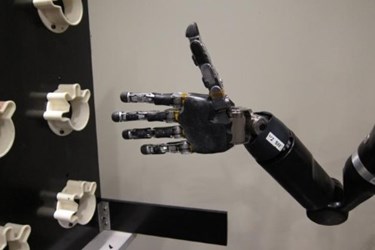Mind-Controlled Robotic Arm Demonstrates Power Of Prosthetics
By Chuck Seegert, Ph.D.

Using just her thoughts, a quadriplegic woman used a robotic arm to pick up objects with diverse shapes and orientations. The mind-controlled robotic device she used operated in 10-dimensional space and illustrated the technology’s potential to improve the quality of life for many patients.
The development of active robotic devices is a goal that would assist many patients who are either missing limbs or suffering from some form of paralysis. In the past, controlling these powered devices has been attempted in many ways that have been met with limited success. Some designs tried transcutaneous leads that interfaced with the nerves under the skin, while others used small electrodes to sense muscular twitching in a stump that remained after an amputation. Generally, however, the goal of providing a patient with autonomous control of a robotic limb has not been fully achieved.
An exciting advance toward this goal recently came from University of Pittsburgh researchers, according to a recent press release. To accomplish this, the team surgically implanted a grid with 96 electrodes into the region of a patient’s motor cortex that would normally control her right arm. Each of the leads, or contact points, interfaced with a single neuron. When neural impulses were generated, they were relayed back to a computer. When the patient imagined a certain movement, the computer recorded the firing patterns and signals generated in the motor cortex. Later, when the patient was imagining this same movement, the computer could detect it and would move the prosthesis accordingly.
Associating the neural activity from the patient’s brain and tying it to a specific movement is a technique the team calls “calibration,” according to a recent study published by the team in the Journal of Neural Engineering. Calibration is a fundamental component of the new process and is what enabled the robot to move in 10-dimensional space. The 10 dimensions were divided accordingly: three for translational movements (up, down, in, and out), three for orientation (wrist rotation and flexing), and four different hand shapes. The process of calibration consisted of the patient watching animations and imagining the movements, while the computer captured data.
"[The patient] used the robot arm to grasp more easily when objects had been displayed during the preceding calibration, which was interesting," said co-investigator Andrew Schwartz, Ph.D., a professor of neurobiology at the University of Pittsburgh School of Medicine, in the press release. "Overall, our results indicate that highly coordinated, natural movement can be restored to people whose arms and hands are paralyzed."
Robotic prostheses that are operated by mind-control methods are now being used in the field. In addition to being controlled by a brain-machine interface, some of these prosthetics can also provide the wearer with tactile feedback.
Photo Credit: Journal of Neural Engineering/IOP Publishing
